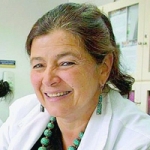 Skin to Skin & Kangaroo Care Online Course(s) & Continuing Education
Skin to Skin & Kangaroo Care Online Course(s) & Continuing Education
Access the latest clinical skills and research for Skin to Skin & Kangaroo Care for POSTPARTUM professional training. These Skin to Skin & Kangaroo Care online courses provide practice-changing skills and valuable perspectives from leading global experts. This Skin to Skin & Kangaroo Care education has been accredited for a variety of CEUs / CERPs and can be accessed on-demand, at your own pace.

Kangaroo Mother Care Now and Then: 30 Years of KMC Clinical and Research Experience in a Developing Country

Dr Nathalie Charpak is currently the scientific coordinator and an attending paediatrician at the Kangaroo Mother Care program of the San Ignacio University Hospital. In addition, she is a founding member, senior researcher and director of the “Fundacion Canguro” in Bogotá, Colombia since 1994. Dr Charpak received her M.D. from the “Paris Sud” University and her paediatrician diploma from “Rene Descartes” University in Paris, France. She migrated in 1986 to Colombia where she validated her title as Paediatrician and begin in 1989 to work on the evaluation of the Kangaroo Mother Care (KMC) program. She is now a Colombian citizen. With several colleagues she founded in 1994 the “Fundacion Canguro” in Bogotá, an NGO devoted to research, teaching, training and direct medical care related to KMC method for premature infants that besides conducting large clinical trials on KMC has been actively disseminating the method mainly in low and middle income countries in Latin America, South East Asia, India, Africa and Eastern Europe. In 1996 in Trieste Italy she was among the group of international researchers, physicians and nurses who founded the International Kangaroo Network -INK- an international alliance devoted to collaborating, enhancing and disseminating the KMC method. Dr Charpak continues to work as an attending paediatrician in the KMC program and his current research interest is in integrative methods for summarizing and putting into action what is known about KMC in the form of evidence-based clinical practice guidelines. She is also recently involved as coordinator in conducting evaluations of long term (adolescents and young adults) neurodevelopment outcomes in preterm infants exposed or not exposed to KMC during the neonatal period.
The Kangaroo Mother Care (KMC) Method is primarily targeting the preterm and/or LBW infants once they are stabilized and adapted to extra-uterine life. KMC has three mayor components: kangaroo position (KP) or direct skin-to-skin contact between the mother and the baby; the kangaroo nutrition (KN) based on exclusive breastfeeding and the kangaroo discharge policies: early discharge in KP at home or in a KMC ward under strict follow up. KMC is a tool for humanization at all levels of neonatal care. There is sound scientific evidence for the effectiveness and safety of KMC in terms of mortality, early infectious morbidity, development, promotion and maintenance of breastfeeding. Also, there is evidence for the beneficial effects of KMC on establishing healthy bonding between mothers and infants. Many health professionals consider KMC as a means of protecting the immature brain when it is the most fragile and the results of our long term follow up are supporting this hypothesis.

View Details / Enroll


For over 25 years, Caroline has had the pleasure of advising new mothers, growing families, and breastfeeding babies. Along with being a certified lactation consultant in private practice, she leads a weekly parenting and breastfeeding support group for moms and their babies through six months of age. For nearly two decades at a community hospital, she taught prenatal breastfeeding classes. She works among a team of lactation consultants in a thriving postpartum unit. Caroline also practices as a nurse practitioner at a pediatrician’s office. As a provider, she enjoys integrating her knowledge and skills from pediatric nutrition and lactation into primary care. Currently working on a breastfeeding book for new moms, she remains passionate about using various means to teach breastfeeding and help families get off to a great start.
Out of desperation to improve the morbidity and mortality rates of premature infants in Bogota, Colombia, innovative neonatologists developed the concept of kangaroo care . Since then, it has been modified to skin to skin care in NICU’s across the world. In recent years, the benefits of this care have been demonstrated and extended toward use in the full-term infant. With a fresh perspective, application of principles from infant development, anatomy, and physiology, are integrated to realize advantages of incorporating skin to skin through 12 weeks of age. When done correctly, skin to skin time serves as tummy time, minimizes the incidence and severity of acquired plagiocephaly, and provides a gentle treatment for torticollis. Learn how to engage, educate, and empower new families to succeed with this breastfeeding friendly intervention.

View Details / Enroll

Zero Separation of Mother and Newborn: The Science Behind the Concept

Dr Nils Bergman calls himself a Public Health Physician, and currently promotes and researches skin-to-skin contact on a fulltime basis.
He is an Honorary Senior Lecturer at the University of Cape Town, South Africa, and a research affiliate of the South African Medical Research Council.
Dr. Bergman was born in Sweden and raised in Zimbabwe, where he also later worked as a mission doctor. He received his medical degree (MB ChB) at the University of Cape Town, and later a Masters in Public Health at the University of the Western Cape. During his years in Zimbabwe he completed a doctoral dissertation (MD, equivalent to PhD) on scorpion stings. He has worked in rural South Africa, Zimbabwe and Sweden, and his last posting was Senior Medical Superintendent of Mowbray Maternity Hospital in Cape Town, overseeing 18000 births per year.
He enjoys sharing the wildlife of Africa with his wife and three youngsters.
Topic: Zero Separation of Mother and Newborn: The Science Behind the Concept - [View Abstract]
The central dogma of all biological processes is based on DNA and genes, how these make proteins and specifically neurons, and how such neurons result in a brain producing behaviours, with the overriding objective of ‘reproductive fitness’. This presentation translates this dogma to the context of human birth, with the emphasis on the role of the environment is epigenetically informing genes how to make protein, through environmental sensory inputs formatting the brain to that environment, in which reproductive fitness encompasses not just survive but also thrive. The perinatal period is crucial to a number of biological processes, with the mother’s body being the defining environment for human newborns. These can be listed as transition to extra-uterine life, early suckling and colostrum protection, microbiota protection, sensory regulation of physiology, and sensory bonding to parent, synchrony of state organisation with feed and sleep cycling, synchrony and sensitization to and of the mother (and father) with a narrow window of opportunity in the first day. All these processes are place dependent, i.e. only happen in immediate and continuous maternal-infant skin-to-skin contact. Separation has immediate adverse consequences, disrupting all described above. It is not merely a temporary hold up of positive development; it is an active adaptation of stress biology with life long consequences for social and physical health. Bowlby first described this concept as the “Environment of Evolutionary Adaptedness”, Narvaez provides contemporary updating in the “Evolved Developmental Niche”.

View Details / Enroll










